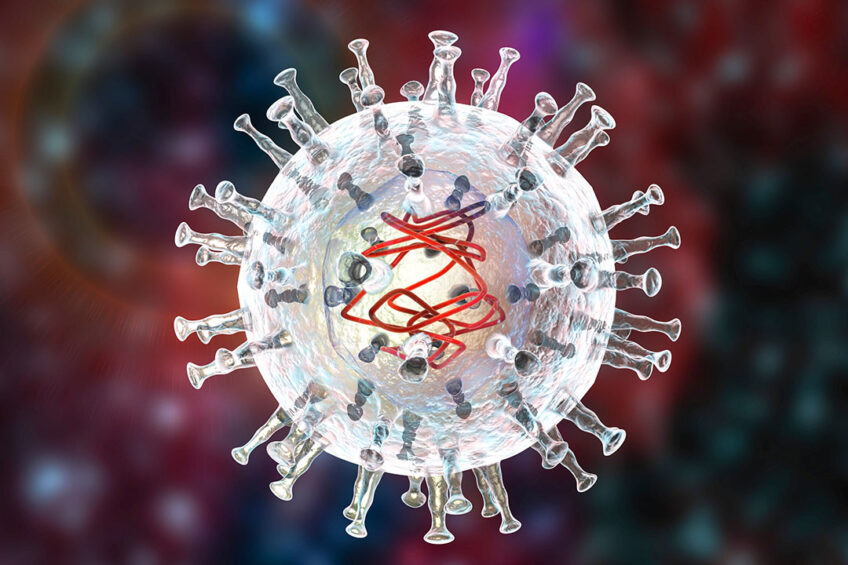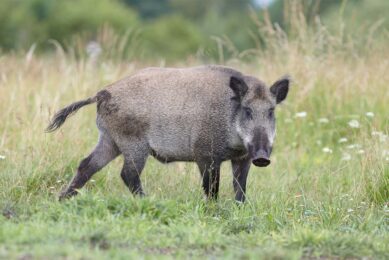China develops new ASF vaccine candidate

Researchers from China have designed a live-attenuated vaccine candidate. This increases the understanding of ASF virus gene function, virus attenuation, and protection against ASF infection.
The current findings on the development of a new ASF vaccine candidate were published in the Journal of Virology. Only Vietnam developed and approved a commercial vaccine against ASF thus far. Recent reports show there is hope for more vaccine development as scientists from Australia and the USA are also teaming up to develop a vaccine.
ASF virus
The ASF virus (ASFV) is the etiological agent of the ASF disease. It is an enveloped, icosahedral, double-stranded DNA (dsDNA) virus. Its genome length ranes from 170 to 193 kb, encoding several proteins with diverse functions.
The multigene family (MGF) members are a large kind of proteins. These are mainly encoded at both ends of the ASFV genome. MGFs can be divided into 5 families, including MGF100, MGF110, MGF300, MGF360, and MGF505.
As shown in previous studies, the MGF505-7R gene is a key virulence-related gene. It is related to immune evasion and viral pathogenicity. Similarly, research shows the ASFV capsid structure contains several proteins. This includes 1 major (p72) and 4 minor (pM1249L, p17, p49, and pH240R) capsid proteins. Like the MGF505-7R gene, the H240R gene is also virulence-related.
The development of a live-attenuated vaccine (LAV) is one of the approaches to antagonise ASFV infection and prevent ASF disease. Research shows that LAVs can be generated by deletions of a single gene or a group of genes related to viral virulence.
Generating the ASF vaccine candidate
Understanding ASFV genetic signatures is critical for developing ASF vaccines. According to the Chinese researchers, compared to obtaining naturally attenuated isolates, genetic manipulation by deletion of the key virulent-related genes is a valid alternative and safer methodology to develop effective ASF live-attenuated vaccines. In the current study, researchers developed a new recombinant ASFV-ΔH240R-Δ7R by combining the deletion of H240R and MGF505-7R genes, which showed protective effects against a challenge with the parental homologous virus in piglets.
“We generated a new live-attenuated vaccine candidate (ASFV-ΔH240R-Δ7R) by deleting H240R and MGF505-7R genes from the highly pathogenic ASFV HLJ/18 genome. We noticed that ASFV strains with deletion of a single gene such as ASFV-Δ7R or ASFV-ΔH240R, still have virulence. So, it is necessary to continue to generate safer and more effective live-attenuated virus strains by deleting two or more genes.”
The deleted viral genes (H240R and MGF505-7R genes) are located separately in different regions of the ASFV genome. Studies show that the recombination process is one of the drivers of double-stranded DNA (dsDNA) virus evolution or mutation. To test the stability of the recombinant ASFV-ΔH240R-Δ7R against mutations, the recombinant virus was serially passaged in porcine alveolar macrophages (PAMs) 30 times. The results demonstrated that the recombinant ASFV-ΔH240R-Δ7R is relatively stable during the 30-time passages in PAMs.
No clinical symptoms and viral shedding
To evaluate the pathogenicity of ASFV-ΔH240R-Δ7R, the researchers divided 5-week-old healthy specific pathogen-free (SPF) piglets into 2 main groups. They inoculated them with ASFVΔH240R-Δ7R or ASFV-WT (parental virus) intramuscularly at a dose of 103 or 105 HAD50. The team recorded and assessed clinical symptoms. To monitor the transmission or viral shedding of the ASFVΔH240R-Δ7R via direct contact, they housed 4 piglets together with the immunised piglets as cohabitation piglets.
The results showed that all piglets the team inoculated with the parental ASF virus (ASFV-WT) had increased body temperature (>40°C) by day 4 post-infection (dpi). They also presented clinical signs associated with ASF disease. All died within 9–10 dpi. Conversely, the piglets that the team immunised with ASFV-ΔH240R-Δ7R (103 or 105 HAD50) did not present any ASF-related clinical symptoms. They remained clinically normal during the entire 28-day observation period.
The results also showed that the piglets that lived with the immunised ones had no viral replication and could not produce specific anti-p30 antibodies. Piglets immunised with ASFV-ΔH240R-Δ7R were safe without any ASF-related signs and produced specific antibodies against p30.
“We speculated that the ASFV-ΔH240R-Δ7R-immunised pig could not shed the virus to infect the cohabitation piglets or extremely low level of viral shedding could not induce protective immune responses.”
Protection against challenge with parental virus
Immune protection efficiency is a key indicator for evaluating vaccine candidates. In the animal, the live-attenuated vaccines are expected to induce protection against their virulent parental viruses. In the current study, to assess the ability of ASFV-ΔH240R-Δ7R to induce protection against the lethal challenge of ASFV HLJ/18 (parental virus), both piglets immunised with ASFV-ΔH240R-Δ7R and the cohabitation piglets were challenged with 102.5 HAD50 of ASFV HLJ/18.
The cohabitation piglets showed ASF disease-related signs by 5 dpi. Disease severity rapidly increased until death between 10 and 12 dpi. On the other hand, the 2 groups (103 and 105 HAD50) immunised with ASFV-ΔH240R-Δ7R survived the ASFV parental virus challenge. They showed no ASF-related clinical symptoms during the 21-day observation period. However, few pigs from the low dose ((103 HAD50) showed elevated temperature in the late stage of infection, but without ASF-related clinical symptoms.
Conclusions
The researchers concluded that high doses of ASFV-ΔH240R-Δ7R vaccination provide better protection against a virulent ASFV challenge. “Challenged with a virulent ASFV HLJ/18, the piglets immunised with a high-dose (105 HAD50) vaccine candidate exhibited 100% protection without clinical symptoms. They showed low levels of virus replication. Postmortem and histological analysis showed no pathogenicity. Our study marks a potential live-attenuated ASFV vaccine that can contribute to ASF preventive strategies. It can rationalise the understanding of ASFV gene function for further vaccine development.”
 Beheer
Beheer








 WP Admin
WP Admin  Bewerk bericht
Bewerk bericht